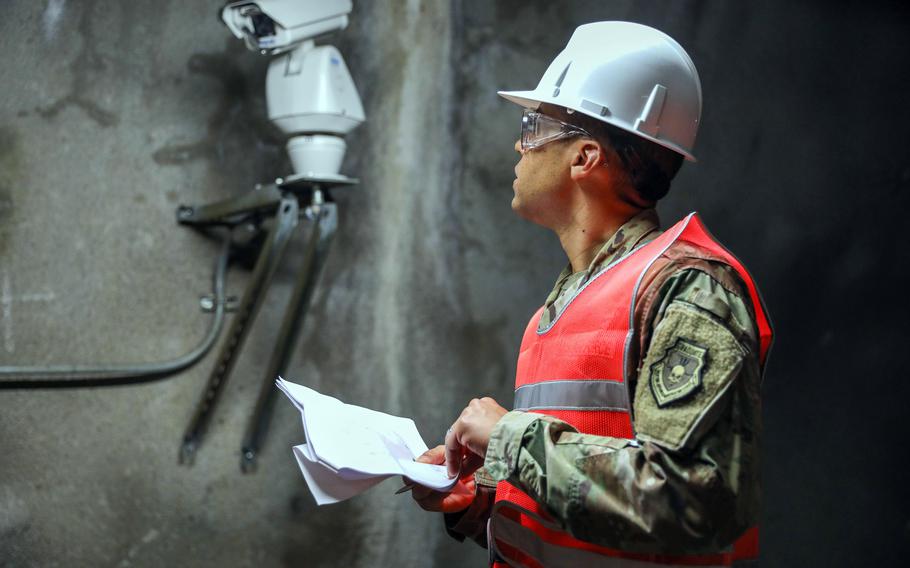
A member of Joint Task Force-Red Hill conducts a safety check at the Red Hill Bulk Fuel Storage Facility in Honolulu, Sept. 14, 2023, in preparation for final defueling of the tanks slated to begin Oct. 16. (Kyler Chatman/Department of Defense)
FORT SHAFTER, Hawaii — The Defense Department will begin emptying millions of gallons of fuel from the defunct Red Hill Bulk Fuel Storage Facility in Honolulu next week after state officials on Tuesday signed off on defueling plans.
The job will take about three months, according to Joint Task Force-Red Hill, the entity overseeing the operation.
The Hawaii Department of Health gave the task force conditional approval to begin emptying 104 million gallons of fuel on Monday.
“Today’s conditional approval marks an important milestone in the process that will ultimately result in permanent closure of the Red Hill Facility and remediation of our aquifer,” Kathleen Ho, deputy director of environmental health for the Department of Health, said in a news release Tuesday.
The approval is conditional on the task force’s adherence to requirements placed on the operation by the Department of Health, which will have staff onsite to oversee defueling, the news release said.
The U.S. Environmental Protection Agency gave the plans the green light last week.
Defense Secretary Lloyd Austin in March 2022 ordered the World War II-era underground storage facility permanently closed after jet fuel leaked from its tanks and contaminated nearby well water in late 2021.
Plan, prepare, rehearse
That contaminated well was part of the Navy’s distribution system that supplied tap water to about 93,000 people living in military communities on and near Joint Base Pearl Harbor-Hickam. Thousands of residents were forced to relocate to area hotels for several months.
The tanks sit about 100 feet above an aquifer that supplies much of Honolulu’s tap water.
The start of defueling on Monday comes after more than a year of planning, repairing and training by the Red Hill task force.
Nearly 300 repairs and enhancements were required to the vast underground piping system to safely defuel, the Health Department said in the news release.
“After months of methodical planning, preparing and rehearsing, we are ready to begin defueling Red Hill and setting the conditions for its closure,” Vice Adm. John Wade, the task force commander, said in a news release Monday.
“We have taken significant precautions to mitigate risk for safe operations, ensure preparedness to respond to contingencies, and protect the aquifer, environment, and human health as we defuel the facility,” he said.
Fuel will drain via gravity through roughly 3 miles of pipes that end at a fueling pier on the joint base.
San Diego, Subic, Singapore
The fuel will be loaded onto tanker ships and relocated to San Diego, Subic Bay in the Philippines, the Port of Singapore and a pair of fuel depots in Hawaii, the task force said in a statement Tuesday in response to a query by Stars and Stripes.
“We expect the removal to take 9 movements,” the task force said.
Filling a tanker takes about 52 hours, the task force said in a fact sheet on the defueling process.
The first transport ship, the merchant tanker Empire State, is slated to arrive at Pearl Harbor early Wednesday morning, the task force said in an advisory on Monday.
The first phase of defueling will require two of the facility’s three main pipelines, bringing the fuel level in the tanks to about 10 feet.
That remaining fuel will be drained using a connection newly built for the defueling process, the Health Department said in its letter of conditional approval.
Among the required upgrades to the facility were improvements to fire-suppression equipment and beefed-up spill mitigation measures, such as the sealing of drains and construction of diversion berms.
The Navy has set up temporary air monitoring stations on Joint Base Pearl Harbor-Hickam and at adjacent military housing communities with an eye toward the defueling process, the Honolulu Star-Advertiser reported Monday
The monitoring is “part of a greater spill response strategy to identify, quantify and assess potential threats to public safety, should there be a spill during the defueling of Red Hill,” a Navy spokesperson told the newspaper.